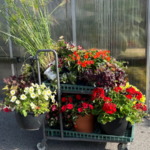
Marketing Trends to Avoid in 2021
In a world where digital has become an integral piece of every garden center’s marketing strategy, there is only one thing worse than having no strategy at all — having a bad digital marketing plan based in bad habits. We’re taking a look at some of the marketing trends your business should avoid throughout 2021 and beyond.
Spamming Your Customers
One of the cardinal sins that many small business owners commit when it comes to digital marketing is “spamming” their customer base — continually inundating them with emails and social correspondence. Aside from the obvious privacy laws and FTC compliance issues that can arise from spamming your customers, it’s just bad business and will eventually drive their business elsewhere.
The risks of “spamming” can be eliminated by mapping out your marketing strategies and promotions to make sure there is very little (if any) overlap. When sending promotional emails, for example, make sure there is a timeline that you are following — one that lays out specific dates for email sends, and a tactical approach to what’s being sent. This is the perfect way to make sure you’re sharing just the right amount of content with your audience.
Posting Too Much
Many business owners equate the number of times a garden center posts on social media daily or weekly with the amount of people they will reach — and they couldn’t be more wrong.
While posting multiple times is a good way to stay engaged with your audience, the number of posts has no weight on the amount of people you’ll reach in a news feed. Take Facebook, for example. The number of times posted has nothing to do with your garden center page’s ability to reach a wide audience, but rather, the content you are sharing.
When you post multiple times at once, Facebook will show all of those posts to your audience in one grouping — totaling the same amount of exposure as if they were spread out. Therefore, what your page is sharing, and how you’re engaging with your audience on the content that is shared, is much more important than the amount of content being shared daily.
Sharing Unoriginal Content
Going hand-in-hand with avoiding posting to social channels too much, making sure you’re sharing organic and original content is arguably one of the most important pieces to an effective social media marketing strategy.
Facebook, Instagram and LinkedIn have all announced news feed changes in recent years that prioritize organic, original content over articles and shares. On Facebook and LinkedIn, for example, native images with captions that engage users are seeing two and three times the engagement rates of sharing a simple link with a short caption. On Instagram, the feeds are prioritizing content that is non-sponsored and highly engaged with, including likes and comments.
Prioritizing videos is a great way to help your garden center fall into this rut of posting unoriginal content. According to Oberlo, social posts that contain video see, on average, 48% more engagement and interaction than standard text or image posts.
Make sure that, if you’re sharing articles and written content, you’re mixing in some pieces from your own company’s website as well. And if possible, share as much organic content as possible, including photos, graphics, videos or polls.
Ignoring Engagement
Sometimes, when the focus gets shifted to content, garden center owners forget to keep up with the “social” side of social media — and the engagements that come with it.
Responding to comments on an image or post, for example, is a great way to keep the conversation going, and gain favor with the social algorithms, like Facebook’s news feed. Keeping up on incoming messages through Facebook messenger and Instagram and Twitter’s direct message features are also vital to keeping up your company’s response rate — especially on Facebook, where it shows your response times directly on the page.
Social media is meant to be “social,” and should first and foremost always be centered around engaging with other users — keeping up with comments, messages, questions, concerns, and more can help your company maintain a professional, yet positive, reputation on the various social channels.
Spreading Content Too Thin
In a day and age where the number of social media channels is seemingly endless, garden centers should beware of spreading their content too thin.
Think of it like you think of your customer base. Would you rather receive one customer each from five different marketing channels? Or would you rather receive 15 across two channels? This same approach can be applied to social media.
Instead of trying to make sure your garden center is on the latest-and-greatest social channel (we’re looking at you, TikTok), focus instead on creating high-quality content where you already are (or where you’re already seeing the highest level of engagement from customers).
This isn’t to say there isn’t value in new channels such as TikTok. If your audience is seemingly active on TikTok, it may be worth looking at for your garden center. But keep the quality of your content in mind before diving into new social platforms.
Writing Long Posts
For Facebook and Instagram specifically, it is important that your organic posts keep the text to a minimum. This is because of somewhat-recent changes made to the social media platforms’ algorithms that place a higher emphasis on organic images and videos that will garner more engagement.
When posting to these platforms, make sure you’re keeping your text to a minimum of one to three sentences, at most. Also, avoid using links in the text when possible on Facebook (NEVER use links in text on Instagram), instead using the rich link preview that Facebook provides.
Overspending on Advertising
Platforms such as Facebook, Instagram and Twitter provide small business owners with excellent ways to execute paid advertising campaigns. But you don’t necessarily need to spend “big money” in social media advertising to get your desired results.
Using customer data and current social audience data, identify your key demographic and their interests, purchase behaviors and more using your chosen social media platform’s advertising dashboards. Facebook, for example, will let you narrow your audience down to not only geographical locations, but specific interests — like other pages, publications or products on the platform.
By identifying your audience early, you can help reduce the amount of “wasted” money spent on those that may not convert, instead targeting an audience that is highly likely to follow through on your desired objective.


















 Videos
Videos





